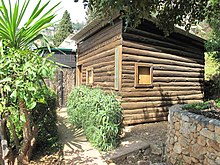Le Cabanon
Le Cabanon ( French for “the hut”) is what the architect Le Corbusier called his small holiday home on Cap Martin on the French Riviera . He built the prefabricated wooden structure in 1952 on the basis of the Modulor .
History and description
On December 30, 1951, le Corbusier drew the plans for a small "hut", a room 3.66 by 3.66 m and 2.26 m high, which he built the following year on a rock above the sea. At the beginning of the 1950s, Le Corbusier had acquired a small hillside property above the villa E1027 from designer Eileen Gray in Roquebrune-Cap-Martin . Here he develops his projects Roc and Rob . While the first - a holiday village with 30 to 80 residential units and a restaurant - remains on paper, the second - living cells for campers - is still partially preserved. Next to it, hidden under a huge fig tree, is a wooden house, the cabanon . The small timber construction draws on the construction method of knitting and block construction. The idea of a room cell of 3.66 × 3.66 meters with all the facilities required for living corresponds to the functional requirements of the ship's cabin, yacht, houseboat or caravan. The room is sparingly furnished. Le Corbusier puts into practice the ideal dimensions 2.26 × 2.26 × 2.26 meters for a residential unit developed in his Modulor I and II . The ratio of the ceiling height to the side of the room corresponds to the golden ratio . The interior design is also his work: functional, space-saving wooden furniture with a toilet that is only separated by a curtain and integrated into the living room. A kitchen was not planned because a small restaurant in the neighborhood provided Le Corbusier with the essentials.
World Heritage Site
In January 2008, France had fourteen buildings and facilities of Le Corbusier in the tentative list of UNESCO register, including Le Cabanon . Such a procedure is a prerequisite for applying for recognition as a World Heritage Site at a later date . In this case, however, this happened at the same time: under the leadership of France and with the participation of the Fondation Le Corbusier , these fourteen and initially nine works by Le Corbusier from six other countries were named "The urbanistic and architectural work of Le Corbusier" ( French Œuvre urbaine et architecturale de Le Corbusier ) nominated for inclusion as a World Heritage Site. Despite having been revised and reduced to 19 objects in the meantime, the World Heritage Committee did not find a majority at its annual meeting in June 2011. Only a revised list of now 17 works by Corbusier - including Le Cabanon - was finally entered on the World Heritage List in September 2016. Like Villa Le Lac from 1923–24, Le Cabanon was recognized as an early and influential example of a functional, ergonomic and standardized minimal house.
literature
- Alfred Werner Maurer : Le Corbusier and the Mediterranean , Philologus Verlag Basel (CH) 2006.
Web links
Individual evidence
- ^ L'œuvre architecturale et urbaine de Le Corbusier . Entry in the tentative list of UNESCO on their website, accessed on April 10, 2014 (French)
- ↑ UNESCO dossier Le Corbusier signed in Paris . Press release of the Swiss Federal Office for Culture, January 30, 2008, accessed on April 7, 2014
- ↑ Joseph Hanimann: Whole or not at all Süddeutsche Zeitung, June 29, 2011, accessed on April 7, 2014
- ↑ Entry on the World Heritage List: The Architectural Work of Le Corbusier, an Outstanding Contribution to the Modern Movement. UNESCO website, accessed on November 13, 2016.
- ↑ International Council on Monuments and Sites : Advisory Body Evaluation. 2016, p. 233 (PDF). UNESCO website, accessed on November 13, 2016.
Coordinates: 43 ° 45 ′ 35.7 " N , 7 ° 27 ′ 48" E

